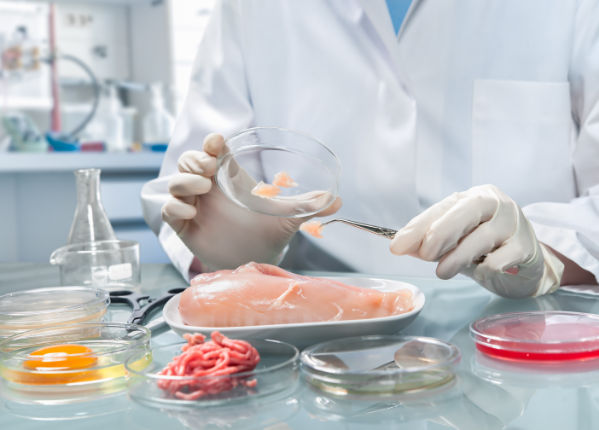
Universality, Reliability and Cost-Effectiveness in Food Analysis: An Application Review in HPLC and U-HPLC
Among the detectors available in Liquid Chromatography (LC), Evaporative Light-Scattering Detector (ELSD) became in recent years a well established instrument thanks to several theoretical studies based on fundamental investigations and numerous applications provided during the last thirty years. Indeed, ELSD is considered as a nearly Universal, powerful, reliable and cost-effective technique, and is ideally appropriate in Food industry for a great variety of LC applications containing chromophoric and non-chromophoric compounds. Today, the power of this detection mode is further extended with the ultimate model which proposes a genuine and efficient Low-Temperature technology (LT-ELSDTM) combined with an innovative detection chamber, thus providing the highest sensitivities with all compounds including semi-volatile and thermo-labile ones.
To show the strength and the versatility of this ELSD model, several LC methods applicable to Food analysis are developed in this work. These applications use the most recent LC media, such as HILIC, sub-two-micron or fused-core particle phases, allowing outstanding separations and simultaneous analyses of a wide range of chemical and biochemical compounds. This work proposes several selected LC-ELSD methods and includes the analyses of the following groups of compounds:
- Sugars and Polyols
- Sweeteners
- Lipids
- Amino acids
- Vitamins
- Minerals and inorganics salts
- Aroma Chemical Compounds

1. Carbohydrates and Polyols

- Glycerol (0,78min)
- Rhamnose (0,91min)
- Arabinose (1,13min)
- Fructose (1,31min)
- Sorbitol (1,53min)
- Glucose (1,85min)
- Inositol (2,88min)
- Saccharose (3,55min)
- Maltose (4,30min)
Conditions:
Injection Volume: 2µl (500ppm each)
Column: Imtakt UK-Amino 3µm, 2.0x150mm, 60°C
Flowrate: 0.8mL/min
Eluent: A.Water / B.Acetonitrile
Gradient: 0 to 2min :10%A, 2 to 3min: 10 to 20%A, 3 to 5min: 20%A
Detector: SEDEX LT-ELSD Model 90LT, 30°C, 3.5bar
2. Sweeteners: Natural and Artificial
- Erythritol (2,45min)
- Sucralose (3,61min)
- Sorbitol (5,47min)
- Neotame (6,04min)
- Acesulfame K (6,79min)
- Neohesperidin dihydrochalcone (7,35min)
- Saccharin (7,92min)
- Aspartame (8,45min)
- Cyclamate (8,8min)
- Rebauside A (From Stevia) (9,68min)
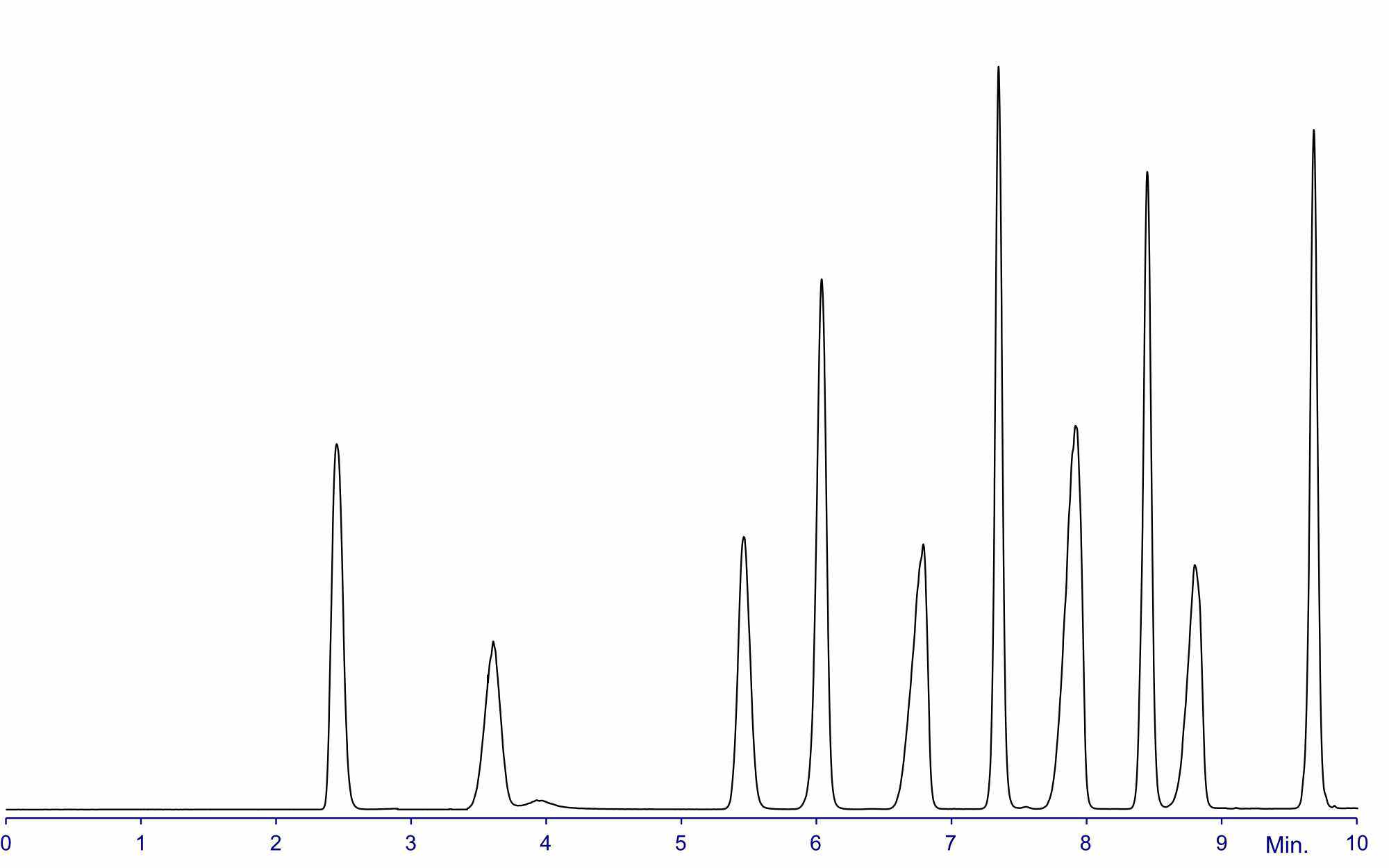
Conditions:
Injection Volume: 2µl (500ppm each)
Column: Hypersil GOLD Hilic 1.9µm, 2.0x150mm, 40°C
Flowrate: 0.5mL/min
Eluent: A.Ammonium Acetate 50mM pH5 / B.Acetonitrile
Gradient: 0 to 0.5min :5%A, 0.5 to 10min: 5 to 30%A
Detector: SEDEX LT-ELSD Model 90LT, 35°C, 3.5bar
3.Lipids: Analytical Monitoring of Biodiesel Production
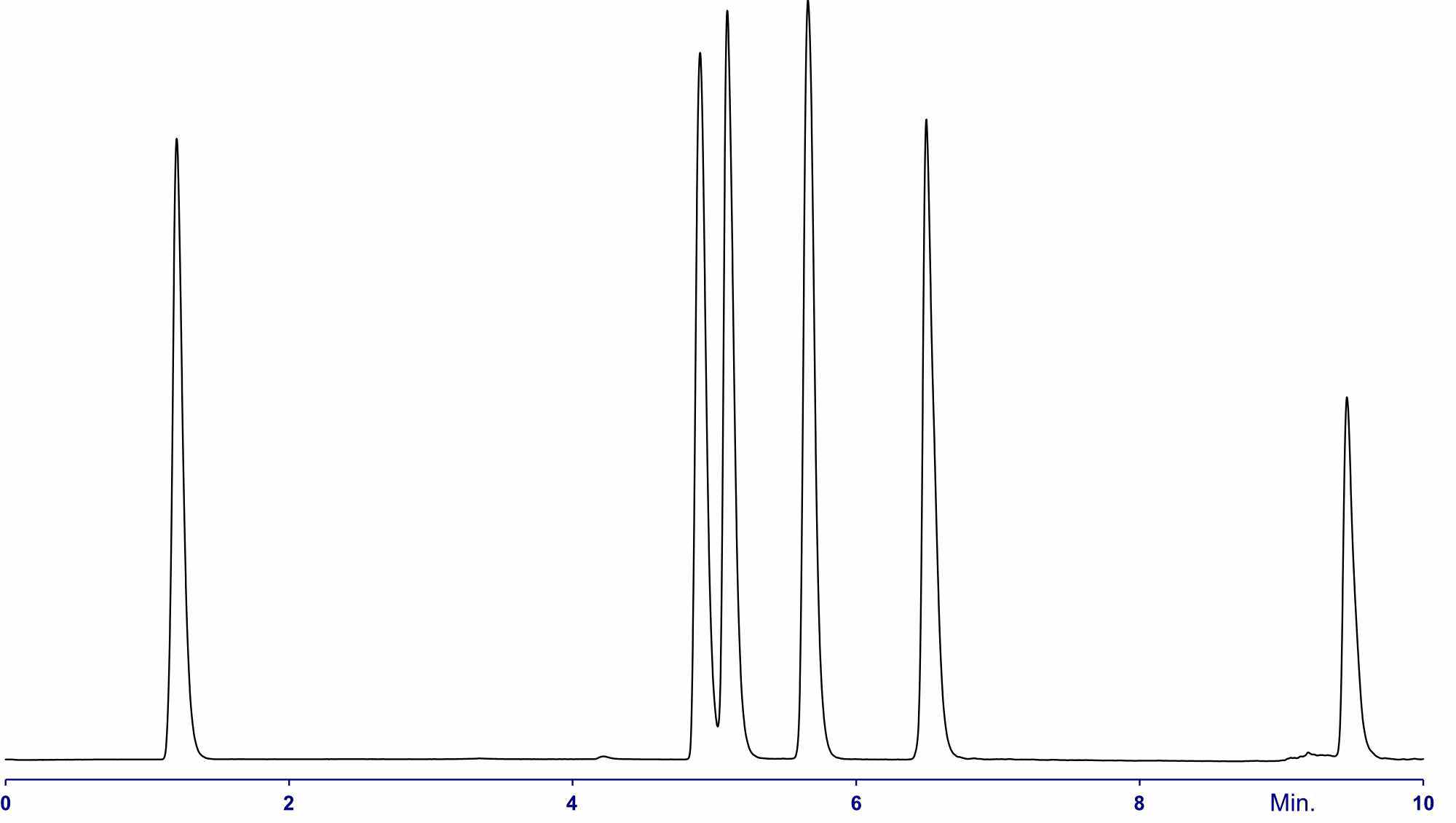
- Tripalmitin (1,21min)
- 1,3 Dipalmitin (4,90min)
- 1,2 Dipalmitin (5,09min)
- Palmitic Acid (5,66min)
- Monopalmitin (6,49min)
- Glycerol (9,46min)
Conditions:
Injection Volume: 2µl (250ppm each except Glycerol: 1000ppm)
Column: Synchronis Amino 1.7µm, 2.1x100mm, 30°C
Flowrate: 0.5mL/min
Eluent: A.Hexane / B.Acetone + 0,2% Formic Acid
Gradient: 0 to 1min: 100%A, 1 to 6min: 100 to 50%A, 6 to 8min: 50 to 100%A
Detector: SEDEX LT-ELSD Model 90LT, 28°C, 3.5bar
4. Underivatized Amino Acids: Essential and Semi-Essential
- Phenylalanin (2,02min)
- Tryptophan (2,13min)
- Leucin (2,26min)
- Isoleucin (2,47min)
- Methionin (2,62min)
- Tyrosin (2,86min)
- Valin (3,21min)
- Cystein (3,44min)
- Threonin (4,43min)
- Histidin (6,81min)
- Arginin (7,05min)
- Lysin (7,48min)
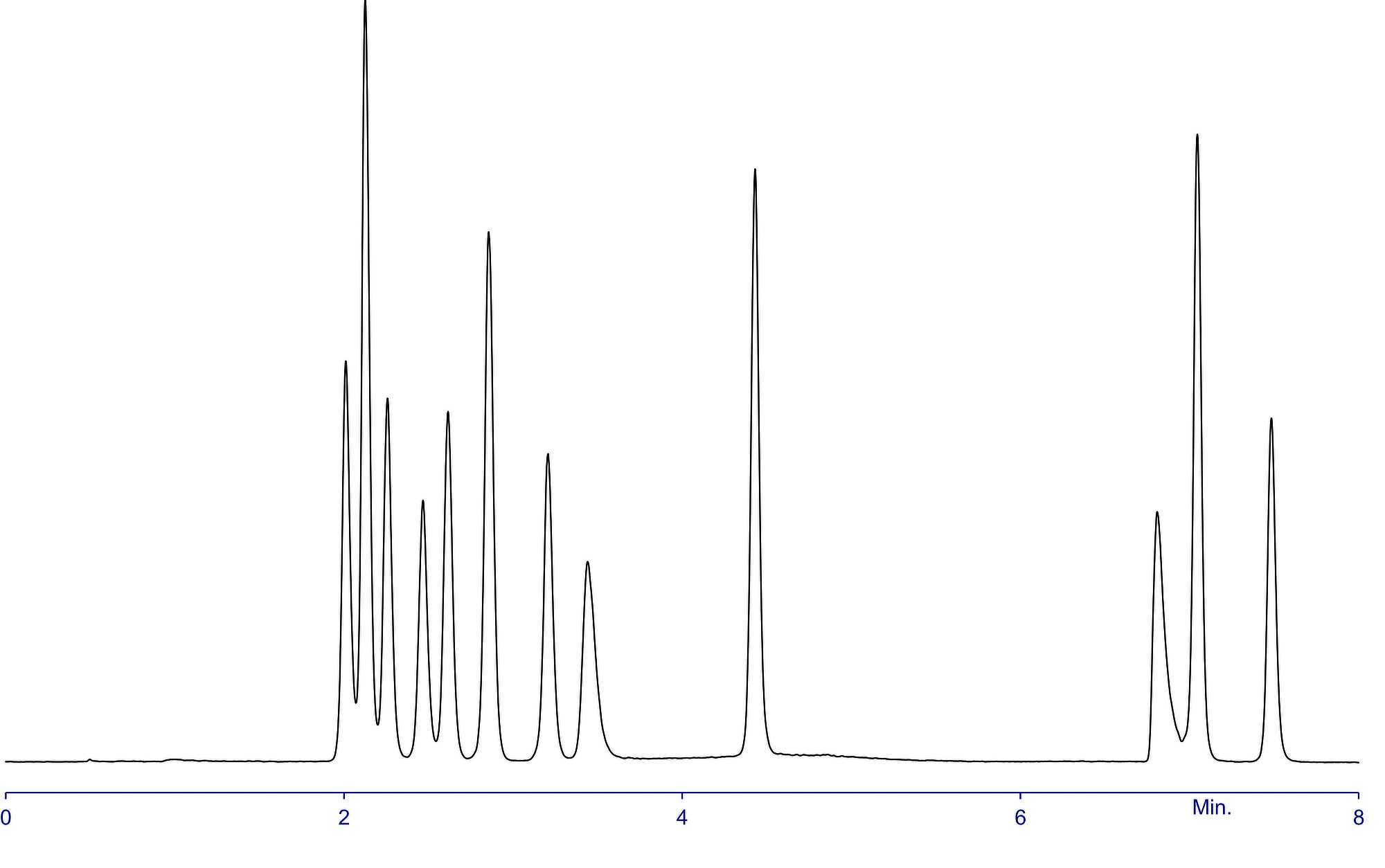
Conditions:
Injection Volume: 2µl (250ppm each)
Column: Synchronis Hilic 1.7µm, 2.1x100mm, 30°C
Flowrate: 0.5mL/min
Eluent: A.Amonium Formate 100mM pH3 / B.Acetonitrile
Gradient: 0 to 1min: 16%A, 1 to 2.5min: 16 to 25%A, hold for 1min, 3.5 to 4min: 25 to 30%A, hold for 4min
Detector: SEDEX LT-ELSD Model 90LT, 40°C, 3.5bar
5. Vitamins, Minerals, Sweeteners, Amionoacids, Salts, Caffeine

- Caffeine(0,95min)
- Vitamin B3 (1,15min)
- Vitamin B6 (2,06min)
- Chloride Ion (2,88min)
- Erythritol (3,10min)
- Vitamin C (4,07min)
- Xylitol (5,67min)
- Potassium Ion (7,87min)
- Sodium Ion (8,17min)
- Rebauside A (From Stevia) (8,47min)
- Taurine (8,95min)
- Magnesium Ion (10,15min)
- Glutamic Acid (10,41min)
Conditions:
Injection Volume: 1µl (500ppm to 1000ppm each)
Column: Ascentis Express Hilic 2.7µm, 2.1x150mm, 30°C
Flowrate: 0.5mL/min
Eluent: A.Ammonium Formate 200mM pH3 / B.Acetonitirile
Gradient: 0 to 1min: 8%A, 1 to 8min: 8 to 25%A, hold 4min
Detector: SEDEX LT-ELSD Model 90LT, 40°C, 3.5bar
6. Aroma Chemical Compounds
- Vanillic Acid (5,15min)
- 2-hydroxybenzaldehyde (5,37min)
- Vanillin (5,65min)
- Syringaldheyde (5,74min)
- Ethylvanillin (6,31min)
- Coumarin (6,54min)
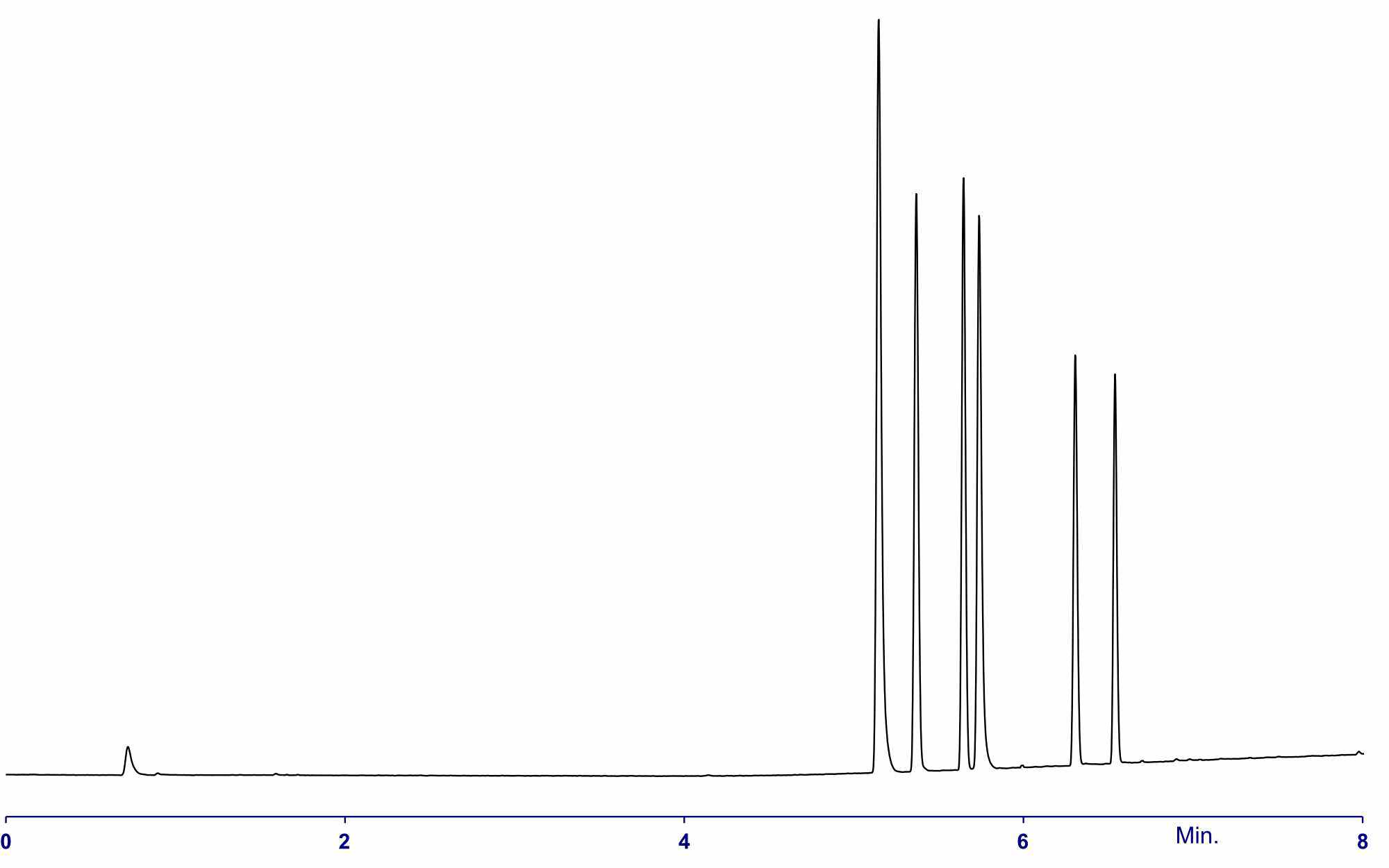
Conditions:
Injection Volume: 1µl
Column: Halo C18 2.7µm, 2.1x150mm, 25°C
Flowrate: 0.4mL/min
Eluent: A.Water + 0.2% Formic Acid / B.Acetonitrile +0.2% Formic Acid
Gradient: 0 to 1min: 5%B, 1 to 7min: 5 to 90%B
Detector: SEDEX LT-ELSD Model 90LT, 28°C, 3.5bar
Conclusion
The examples developed in this work demonstrate the Universal applicability of LT-ELSD in HPLC for various types of both chromophoric and non-chromophoric compounds such as mono- and disaccharides, polyols, artificial and natural sweeteners, fatty acids, mono-, di- and triglycerides, amino acids, vitamins, minerals, inorganic salts, aroma chemicals and phenolic compounds and methylxanthine alkaloids. These applications using just a single Universal detector are straightforward to operate and do not require any additional equipment nor specific tedious sample preparation.
The New SEDEX 90LT benefits from both the Low-Temperature technology and a new optical head design based on a high-performance laser, which results in an outstanding sensitivity increase with LODs typically down to the very low-nanogram levels and RSD in the range of 1-2%.
Moreover, SEDEX 90LT allows the use of acetone which is less toxic and cheaper than many other organic eluents (such as acetonitrile), and which possesses excellent physical and chromatography properties.
As a conclusion, the association of the most recent chromatography media and the new generation of high-performance ELSDs provides the analysts with a quite relevant and cost-effective solution to their separation and quantification challenges in Food area.

